Hanford One
Although there have been dozens of unique nuclear reactors and nuclear power plants built and operated in the United States, it is perhaps true that the "most unique" of these in many ways was a nuclear power plant that, in a real sense, did not itself actually incorporate a nuclear reactor. This plant was built and operated by the Washington Public Power Supply System, and was known as Hanford One. The story behind it, and the unique reactor that provided steam for it, is at once complicated and fascinating.
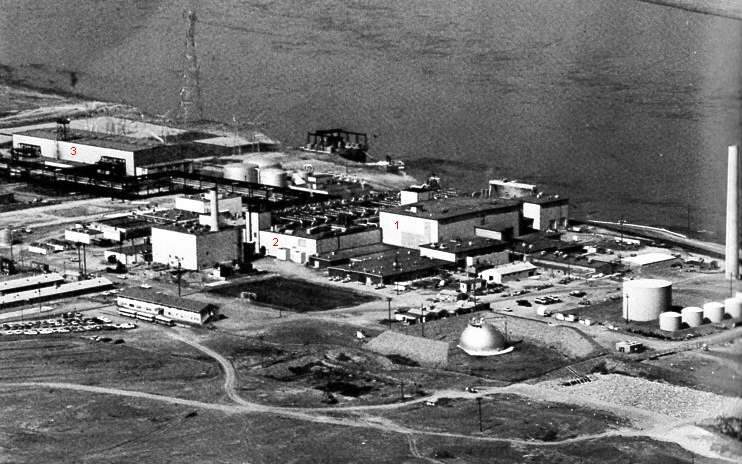
N-Reactor Area, Hanford Site. 1: N-Reactor building 105-N. 2: Steam generator building 109-N. 3: Hanford One steam turbine electric generating plant, building 185-N.
The story of this project begins in 1957 when the US Atomic Energy Commission (AEC) decided to add to the nation's complex of weapons production reactors. Eight of these were running at Hanford, Washington on the 570 square mile Hanford Reservation; five more were running at the Savannah River Site, South Carolina. (The Hanford reactors were graphite pile reactors, while the SRS units were heavy water tank-type reactors.) The addition planned for Hanford was to be a much larger and more powerful reactor, to be designated the "New Production Reactor" or, in the letter code of the day, the "N Reactor." This reactor would also incorporate provision to harness the wasted heat energy (dumped into the Columbia River by all the other reactors at Hanford) and generate electricity with it; studies that the AEC had performed as early as 1953 showed that such a reactor was not only feasible but that it could be economically viable.
The idea itself was not limited to the USA. In fact, two years before this, the UK had announced the completion of its first "nuclear power station" at Calder Hall -- but the reactor put on line that day and another adjoining one later were actually dual purpose reactors, designed to both produce plutonium for weapons and to produce electricity. The New Production Reactor or N Reactor was not different in this regard.
What was different was the scope. N Reactor would be the first reactor in the world to exceed a 4000 MWt power rating, and would be the largest and most complicated unit at Hanford by a large margin. It was expected that water would be used as the coolant, unlike the British reactors which were gas cooled. The reactor used horizontal pressure tubes running through the graphite pile, which carried the coolant in loops to twelve steam generators. There were also over 600 cooling tubes for the moderator. The reactor was theoretically able to be uprated to 4800 MWt, but this was not attempted.
The project proceeded quite slowly, as it ran into a snag; Congress would not allow the Federal Government to get into the commercial electric power business. For this reason, it denied the funds to add the actual electric generating portion of the plant, and construction of N Reactor went ahead without an electric generating plant.
Power demands in the Pacific Northwest were at that time increasing, and were expected to rise much more seriously in the future, so that vast amounts of new generating capacity would be needed within 20 or 30 years. Hydro-electric power was nearly maximized, and nuclear was growing in the minds of those discussing energy in that region. Seeing the N Reactor construction as an opportunity, an "end around" was conducted by the Washington Public Power Supply System (WPPSS) when it proposed to build the steam turbine generating plant itself, with no Federal funding whatsoever. WPPSS would buy the steam from the Government, and generate electricity commercially with it in a new adjacent power plant. After great hand wringing in Congress, President Kennedy signed into law the bill authorizing the Government to sell steam to WPPSS on September 26, 1962. Exactly one year later, President Kennedy presided over the groundbreaking for the new electric generating plant near, but not immediately adjacent to, N Reactor at Hanford. (The illustration at the top of this article shows the large separation of the buildings, and the pipe and cable connection bridge between them is clearly visible.)
WPPSS and the AEC termed this new project as HGP or the Hanford Generating Project; later, WPPSS began referring to it as "Hanford One." It was financed through the sale of $122 million of revenue bonds, and was designed and equipped by General Electric. The turbine plant was controlled completely separately from N Reactor, having a control room on its own site.
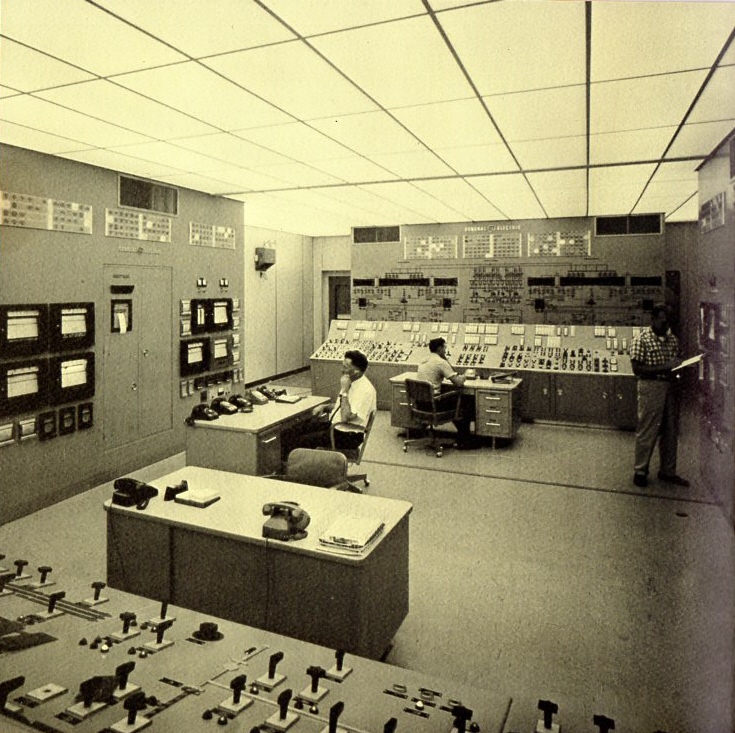
Control Room, WPPSS Hanford One.
The turbine building constructed for this project was fairly enormous. It was 430 feet long, 150 feet wide and measured from 50 feet below grade to 57 feet above grade. Two large General Electric turbine generators were installed head-to-head in the building's main space.
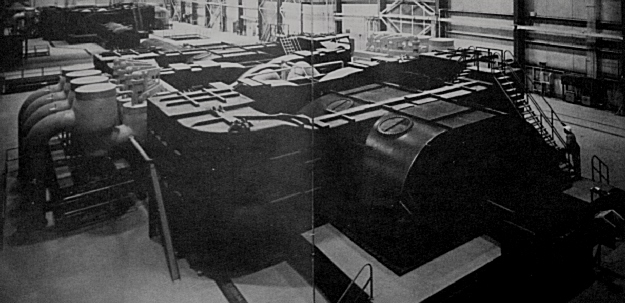
Turbine Generators, Hanford One.
The two turbine generators are seen above. Note the large stop and throttle valves on each side of the near machine; these are flanking the HP or high pressure turbine in the center. On either side of the HP turbine are the two low pressure or LP turbines. The actual electric generator, which provides power to the grid, is on the end away from us; it can be seen that the generator ends of the machines are facing each other.
Each of these machines weighed 3,150,000 lbs, and was rated at 430 MWe. Eight 38 inch diameter steam lines ran on the "pipe trestle" from N Reactor to the generating station; these were reduced to 26 inch diameter as connected to each machine. Because of the nature of the N Reactor's design, the steam that was supplied to these machines was at an extremely modest temperature and pressure when compared with other nuclear plants. Specifically, when N Reactor was operating in its weapons production or "dual" mode, the steam supplied was at 130 PSI and 339F; when the reactor was operating in the mode to generate electric power only, the steam was 300 PSI and 422F. The machines produced 430 MWe each in the latter situation, and 400 MWe each in the "weapons production" or "dual" mode. (The original design of the N Reactor incorporated a "weapons production only" mode with steam dumped to the ten dump condensers. These were retained; normal operation kept these warmed up in case of the need to dump steam suddenly if, for example, one of the Hanford One turbine generators tripped.)
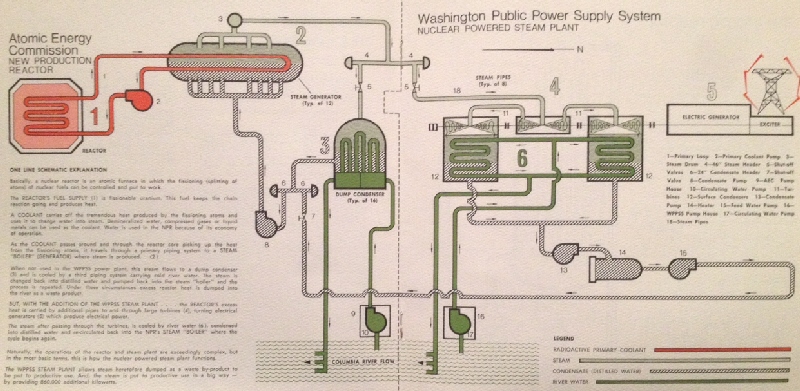
Hanford One / N Reactor power plant basic diagram.
The plant diagram above shows the basics of the overall plant operation. The plant used twelve horizontal steam generators to supply steam to Hanford One -- a design configuration nearly unique in US nuclear plants and most common to Soviet- or Russian-designed PWR type plants.
N Reactor was first started up in 1963, before Hanford One was complete. It was not until April 8, 1966 that Turbine No. 2 was connected to the grid; Turbine No. 1 followed later on June 12. Hanford One was declared to be in commercial operation in November 1966 and on December 9, 1966 the plant achieved its full nameplate rating of 800 MWe (with N Reactor operating in dual mode.)
The nation's needs for plutonium were, at it would happen, largely satisfied by this time and surprisingly in January 1967 N Reactor was shut down. A scramble to get it back operating ensued, and in April the AEC agreed to operate N Reactor in its commercial power only mode to sell steam to WPPSS under a new contract.
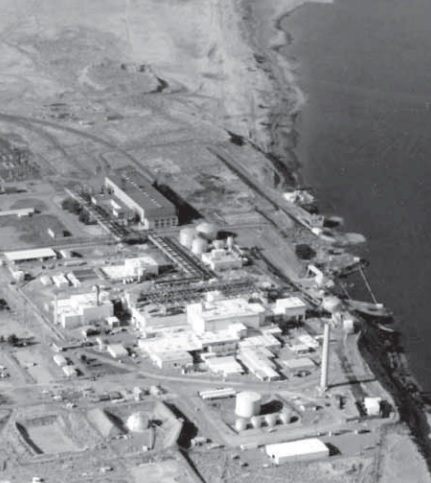
N Reactor Area and WPPSS Hanford One; courtesy Oregon Dept. of Energy.
Although it had been loosely planned that N Reactor would be physically altered and changed over to entirely commercial power production at such time as the AEC had enough plutonium for weapons, political issues arose within a few years and the Office of Management and Budget issued instructions that N Reactor be shut down for good in early 1971. Response -- or, perhaps better, backlash -- in the Pacific Northwest was again immediate and widespread because of the power shortage this would cause. That April '71 the Federal Government backed down and agreed to allow N Reactor to continue to operate until July 1974.
By this time, WPPSS had launched a project to build a new nuclear power plant on the Hanford Reservation but not near the AEC weapons reactors; this was called Hanford Two, or Project Two. Hanford One was more or less expected to continue operating after the 1974 date, and it was assumed that N Reactor's weapons production capacity would be eliminated and that WPPSS would simply take over operation. This plan was however blunted when it was shown that conversion of the reactor to produce only power would be either exceedingly expensive or else impossible. After a series of meetings, in May 1972 WPPSS decided that ultimately the Hanford One plant would need to be essentially replaced, and it made the decision to launch a new "Project One" for this purpose.
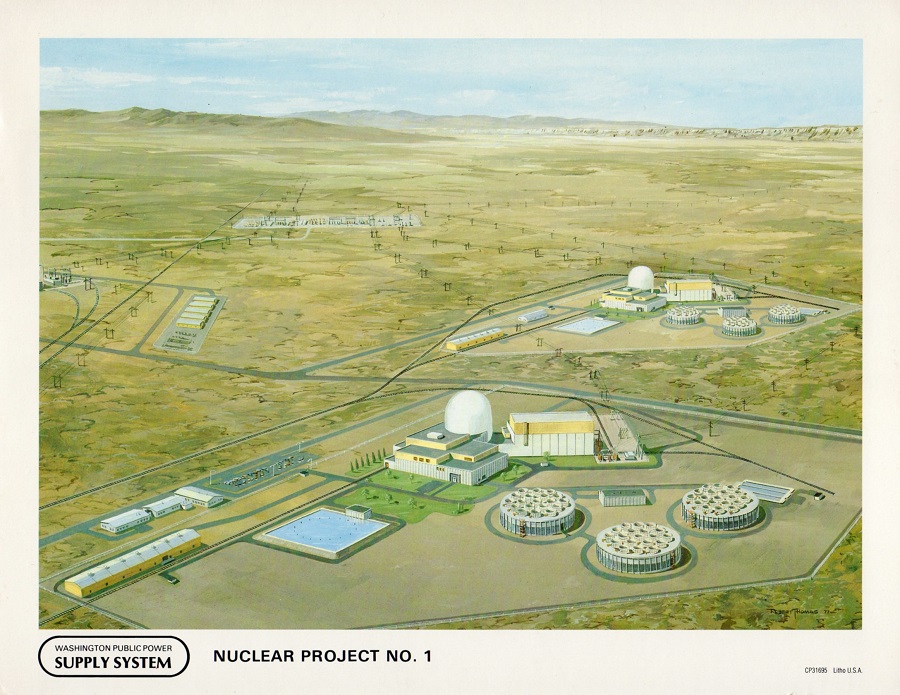
WPPSS Project One. This rare artist's concept in Will Davis' collection shows Project One after it was expanded to include not only Unit 1 (near us) but also Unit 4 (further away.) Both were to have incorporated Babcock 205 Nuclear Steam Supply Systems.
N reactor did however stay in operation beyond the 1974 date, and in fact, in 1980 when it was determined that upgrading of the nation's weapons required more plutonium, the reactor was returned to dual-mode operation.
Hanford One and the N Reactor operated through December 1986 -- long after WPPSS had gone through a tortuous and from a business perspective disastrous process regarding the other nuclear plants it was attempting to construct, all but one of which were never finished (the one that was finished was Hanford Two, today known as Columbia Generating Station.) N Reactor was said to require as much as $50 million worth of modifications and upgrades when shut down at the end of 1986 -- but it never restarted.
In February 1988 it was announced that the N Reactor complex was to be placed in "cold standby" - a condition not unlike "mothballing" of Navy ships, in which the plant was shut down but preserved for future operations. This process took until October 1990. Less than one year later, the Department of Energy directed that the preservation period effectively end, and instructed Hanford to begin to develop an ultimate decommissioning plan for the N Reactor and its area. Between 1991 and 1995, the complicated plans for remediating the area, as well as funding to perform it, were accumulated and the work began to demolish various structures. In 2007, work began to place N Reactor into ISS or Interim Safe Storage - a process that was completed in September 2012.
The operative establishment to commercially generate electricity that we've read about above at Hanford is unique in the nuclear history of the United States. While some of the AEC Power Demonstration Reactor Program projects did see AEC reactors selling steam to utilities (such as at Piqua, Ohio, for example) those other projects were contracted directly with utility companies from the outset. Further, Hanford One is the only generating plant to provide commercial power from a nuclear source located on a US Government / AEC or military base of any sort.
---------
•Illustrations above, unless noted, are from "WPPSS Hanford One" brochure in Will Davis' collection.
•Sources consulted for this article:
"WPPSS Hanford One." Undated brochure published by WPPSS.
"Final Environmental Impact Statement on Continued Operation of the Hanford Generating Project," Washington Public Power Supply System, January 1977.
"N Reactor Deactivation Program Plan," Westinghouse Hanford Company for US Department of Energy, December 1993.
"Closure Report for N Reactor," US Department of Energy, January 1994.
"Scoping Document for the Hanford Generating Plant in the 100-N Area," P. W. Griffin, Westinghouse Hanford Company May 1992.
----------
For more information:
Hanford N Reactor Area Fact Sheet
Hanford Reservation website: N Reactor Area
Interim Safe Storage of Hanford Reactors
 Will Davis is Communications Director and board member for the N/S Savannah Association, Inc. He is a consultant to the Global America Business Institute, a contributing author for Fuel Cycle Week, and writes his own popular blog Atomic Power Review. Davis is also a consultant and writer for the American Nuclear Society, and serves on the ANS Communications Committee. He is a former US Navy reactor operator, qualified on S8G and S5W plants.
Will Davis is Communications Director and board member for the N/S Savannah Association, Inc. He is a consultant to the Global America Business Institute, a contributing author for Fuel Cycle Week, and writes his own popular blog Atomic Power Review. Davis is also a consultant and writer for the American Nuclear Society, and serves on the ANS Communications Committee. He is a former US Navy reactor operator, qualified on S8G and S5W plants.

